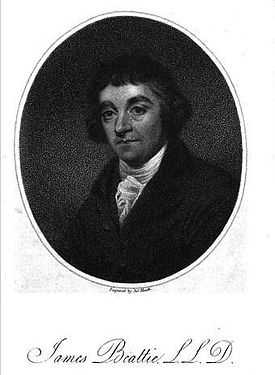James Beattie (poet)
| James Beattie | |
|---|---|
 | |
| Born |
25 October 1735 Laurencekirk, Kincardineshire |
| Died |
18 August 1803 (aged 67) Aberdeen |
| Nationality | Scottish |
| Occupation | scholar, poet |
| Notable work | Essay on the Nature and Immutability of Truth (1770); The Minstrel (1771–74) |
James Beattie FRSE (/ˈbiːti/; 25 October 1735 – 18 August 1803) was a Scottish poet, moralist and philosopher.
Life
He was born the son of a shopkeeper and small farmer at Laurencekirk in the Mearns, and educated at Aberdeen University, graduating in 1753.
In 1760, he was appointed Professor of moral philosophy there as a result of the interest of his intimate friend, Robert Arbuthnot of Haddo. In the following year he published a volume of poems, The Judgment of Paris (1765), which attracted attention. The two works, however, which brought him most fame were An Essay on the Nature and Immutability of Truth, and his poem of The Minstrel. The Essay, intended as an answer to David Hume, had great immediate success, and led to an introduction to the King, a pension of £200, and the degree of LL.D. from Oxford. The first book of The Minstrel was published in 1771 and the second in 1774, and constitutes his true title to remembrance, winning him the praise of Samuel Johnson. It contains much beautiful descriptive writing.
Beattie was prominent in arguing against the institution of slavery, notably in his Essay on the Nature and Immutability of Truth (1770) and Elements of Moral Science.[1]
Beattie was an amateur cellist and member of the Aberdeen Musical Society. He considered questions of music philosophy in his essay On Poetry and Music (written 1762, published 1776), which was republished several times and translated into French in 1798. His poem "The Hermit" was set to music by Tommaso Giordani (1778).[2]
Beattie was co-founder of the Royal Society of Edinburgh in 1783.
Beattie underwent much domestic sorrow in the death of his wife, Mary Dunn, whom he had married in 1767, and two promising sons, which broke down his own health and spirits. He died in Aberdeen in 1803 and id buried there in St Nicholas' Churchyard.[3]
Recognition
A biographical sketch, An Account of the Life of James Beattie, LL.D., was published in 1804 by Alexander Bower.[4]
The poet Robert Burns informed Mrs Frances Dunlop in a letter that the idea of using Coila as the name of his poetic muse first came to him from Beattie's use of a muse named 'Scota' in his Scots language poem of 1768 titled To Mr Alexander at Lochlee.
Beattie is one of the sixteen Scottish poets and writers depicted on the Scott Monument on Princes Street in Edinburgh. He appears on the left side of the east face.
Works

- Original Poems and Translations (1760)
- The Judgement of Paris (1765)
- Poems on Several Subjects (1766)
- An Essay on the Nature and Immutability of Truth (1770)
- The Minstrel; or, The Progress of Genius (1771/2) two volumes
- Essays, on the nature and immutability of truth in opposition to sophistry and scepticism. On poetry and music as they affect the mind. On laughter and ludicrous composition. On the utility of classical learning (1776)
- Essays on Poetry (1778)
- Scoticisms, Arranged in Alphabetical Order, Designed to Correct Improprieties of Speech and Writing (1779)
- Poems on several occasions (1780)
- Dissertations Moral and Critical (1783)
- The Evidence of the Christian Religion Briefly and Plainly Stated (1786) 2 vols.
- The theory of language. Part I. Of the origin and general nature of speech. Part II. Of universal grammar (1788)
- Elements of Moral Science (1790–1793) two volumes
- The Poetical Works of James Beattie (1831) edited by A. Dyce
- The poetical works of Beattie, Blair, and Falconer (1868) edited by Charles Cowden Clarke
- James Beattie's Day-Book, 1773-1778 (1948) edited by R. S. Walker
- James Beattie's Diary (1948) edited by R. S. Walker
Notes
- ↑ "A North East Story: Abolishing the Slave Trade". Retrieved 2009-02-03.
- ↑ David Johnson. "James Beattie". In Macy, Laura. Grove Music Online. Oxford Music Online. Oxford University Press. (subscription required)
- ↑ http://www.royalsoced.org.uk/cms/files/fellows/biographical_index/fells_indexp1.pdf
- ↑
 Sutton, Charles William (1885–1900). "Bower, Alexander". Dictionary of National Biography. London: Smith, Elder & Co.
Sutton, Charles William (1885–1900). "Bower, Alexander". Dictionary of National Biography. London: Smith, Elder & Co.
References
-
 This article incorporates text from a publication now in the public domain: Cousin, John William (1910). A Short Biographical Dictionary of English Literature. London: J. M. Dent & Sons. Wikisource
This article incorporates text from a publication now in the public domain: Cousin, John William (1910). A Short Biographical Dictionary of English Literature. London: J. M. Dent & Sons. Wikisource  Bullen, Arthur Henry (1885). "Beattie, James (1735-1803)". In Stephen, Leslie. Dictionary of National Biography 4. London: Smith, Elder & Co.
Bullen, Arthur Henry (1885). "Beattie, James (1735-1803)". In Stephen, Leslie. Dictionary of National Biography 4. London: Smith, Elder & Co.  Chisholm, Hugh, ed. (1911). "Beattie, James". Encyclopædia Britannica 3 (11th ed.). Cambridge University Press.
Chisholm, Hugh, ed. (1911). "Beattie, James". Encyclopædia Britannica 3 (11th ed.). Cambridge University Press.- Beattie, James, Elements of Moral Science, 1790. Facsimile ed., 1975, Scholars' Facsimiles & Reprints, ISBN 978-0-8201-1167-4.
External links
| Wikimedia Commons has media related to James Beattie (writer). |
| Wikiquote has quotations related to: James Beattie |
- Works by James Beattie at Project Gutenberg
- Works by or about James Beattie at Internet Archive
- Works by James Beattie at LibriVox (public domain audiobooks)

- James Beattie. "An Essay on the Nature and Immutability of Truth, in Opposition to Sophistry and Scepticism (sixth edition; London: Printed for Edward and Charles Dilly, 1778)". Page Images at Google.
- James Beattie entry in the Internet Encyclopedia of Philosophy
|